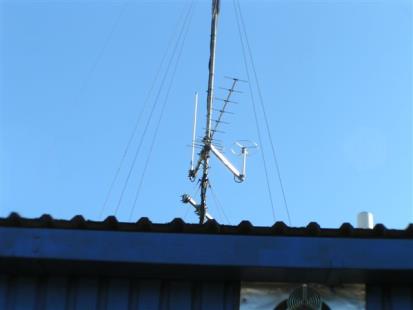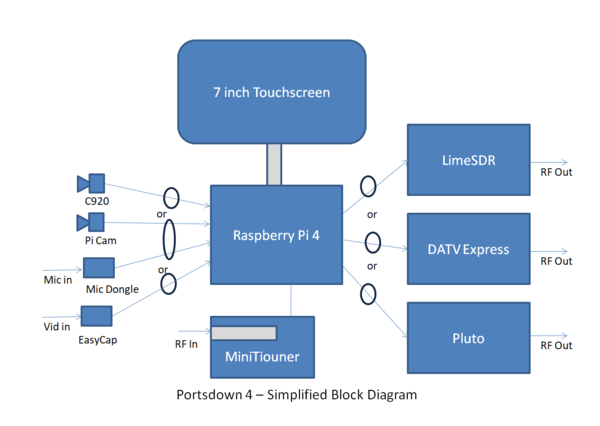DATV DVB-S transmission into GB3ZZ
DATV DVB-S transmission into GB3ZZ
This post is a continuation of A state of tuners but with a focus on VLC RTP, GB3ZZ and DATV transmission. I suggest reading my previous post first.
Current setup
- See comment/description of video: Working GB3ZZ 437 MHz input 2021-07-14
- 1280 x 720 progressive 30 fps MJPG
- Could effect bandwidth or CPU usage.
Videos
VLC
- Useful command to check VLC ports:
watch -d "sudo lsof -i -P -n | grep vlc" - https://wiki.videolan.org/Documentation:Streaming_HowTo/Command_Line_Examples
Local
It wouldn’t accept dvb-adapter on the same colon spaced so had to be a separate flag.
vlc dvb-s://frequency=1316000000:srate=4000000:dvb-fec=1:voltage=0 --dvb-adapter=1
Program has to have a space before.
vlc dvb-s://frequency=1316000000:srate=4000000:dvb-fec=1:voltage=0 :program=2 --dvb-adapter=1
vlc dvb-s://frequency=1316000000:srate=4000000:dvb-fec=1:voltage=0 :program=1 --dvb-adapter=1
I eventually found I could use colons for adapter provided its also spaced.
vlc dvb-s://frequency=1316000000:srate=4000000:dvb-fec=1:voltage=0 :program=2 :dvb-adapter=1
vlc dvb-s://frequency=1316000000:srate=4000000:dvb-fec=1:voltage=0 :program=1 :dvb-adapter=1
The following two commands did not work for me.
vlc dvb-s://frequency=1316000000:srate=4000000:dvb-fec=1:voltage=0 :program=2 :dvb-adapter=1 --sout rtp/ts://localhost:9090
vlc dvb-s://frequency=1316000000:srate=4000000:dvb-fec=1:voltage=0 :program=2 :dvb-adapter=1 --sout http/avi://localhost:9090
Remote
Got this one to work for one channel.
vlc dvb-s://frequency=1316000000:srate=4000000:dvb-fec=1:voltage=0 :program=2 :dvb-adapter=1 --sout '#rtp{dst=192.168.1.173,port=1234,sdp=rtsp://192.168.1.137:8080/test.sdp}'
These work for multi channels although I found the latter works without the need for --sout-all
vlc dvb-s://frequency=1316000000:srate=4000000:dvb-fec=1:voltage=0 :dvb-adapter=1 --sout '#rtp{dst=192.168.1.173,port=1234,sdp=rtsp://192.168.1.137:8080/test.sdp}' --sout-all
vlc dvb-s://frequency=1316000000:srate=4000000:dvb-fec=1:voltage=0 :dvb-adapter=1 --sout '#rtp{dst=192.168.1.173,port=1234,sdp=rtsp://192.168.1.137:8080/test.sdp}'
Client command: vlc rtsp://192.168.1.137:8080/test.sdp
I could also do multicast but I am sticking to unicast as I only intend to watch it on one machine and want to save bandwidth on my LAN.
Notes
- RTL-SDR wont work due to 2.4 MHz band width limitation for GB3ZZ as ZZ TXs 4 MSps which is around 5 MHz bandwidth.
- I can however use a RTL-SDR + SDRangel for local TX monitoring of my 1 MSps signal.
- I wonder if HackRF libraries are what slow down SDR angel.
- TODO: Try pluto with SDRangel.
- Blazer HD4000 will go down to 1 MSps.
- It will also go down to 437 MHz and a bit lower.
- 10000 (Mhz lnb freq in software) + 437 (Mhz freq we want to receiver) = 10437 is the frequency we input into the box so it can account for lnb down shift.
- However its input sensitivity is rather bad that low down.
- It’s worth monitoring the TX output spectrum of your TX device, in my case Pluto SDR.
- I found sometimes it transmits a bit wonky, e.g. broken up signal. In that instance DATV Express needs restarting to fix it.
- I can get 2 MSps with h262 but not h264 on my Pluto.
- h265 I hit CPU limitations on my host PC.
- Blazer works on h262 and h264.
- I haven’t yet gotten 333 KSps to work yet locally. 1 MSps TX works best however I should check the 333 issue isn’t a DATV Express restart issue. Otherwise it maybe just SDRAngel.
- Ryde receiver no dual channel support?
- Observed setups
- TX: DATV Express -> LimeSDR. RX: FreeSAT.
- TX: FR Systems
- TX: DTX 1. RX: FreeSAT.
- Ports down
- A semi umbrella term for a project which can consist of different transmitters.
- Multiple versions of ports down exist see links section.
- LimeSDR
- Pluto SDR
- DATV Express TX board
- MiniTiouner receiver board
- Raspberry PI running custom OS
- The handheld “Satellite Signal Finder” I been informed go down to 1 MSps and 437 MHz.
- h262/MPEG2 are the same.
GB3ZZ extended details
Note this information is subject to change and should only be viewed as a snapshot of the current setup at time of writing.
- The 1249 input is more sensitive because the aerials are much higher and there is a hot pre-amp up the mast.
- Big wheel omnidirectional horizontal antenna for 437 MHz input.
- Height is same as the 2 m talk back antenna approx 2-5 ft off the roof of the building.
- Height for 23 cm input antenna is 20 ft off the roof.
- 08:45 BATC streamer reboots and then again at 16:45. Reboot takes approx 5 mins.
- The big wheel antenna is the only working one at the moment? The Yagi heading towards Minehead doesn’t work?
- There is an automatic antenna switcher for 437 MHz input.
- 10:57 - 12:57 Yagi facing Minehead is active.
- 17:24 - 19:54 Yagi facing Minehead is active.
- The above times are in effect Tuesday to Saturday.
- The rest of the time big wheel is active.
- At all times 23 cm input overrides this so you can operate 23 cm input at any time of day.
- In other words
- When pictures of Bristol are showing on GB3ZZ the big wheel antenna is active.
- When GB3ZZ test cards are showing on GB3ZZ the Yagi facing Minehead is active.
- Ryde receivers only active from 07:00 - 23:00 during summer time. They’re subject to BST.
- 23 cm input and output faces?
- 23 cm output height off roof?
- The 144.750 MHz VHF FM vertical is for talk back. This gets fed into the TS (Transport Stream) of GB3ZZ output.
- Rydes can take 30 seconds to switch as they’re scanning multiple modes.
- Output is two channel multiplexed. Channel 1 is the main channel and has audio left and right separate sources. Channel 2 has no audio normally and is the engineering channel.
- Update: 2021-08-16: 70 cm input is no longer active.
- Update: 2021-09-01: GB3ZZ site decommissioned. TODO: Find exact date.
- Update: 2022-01-10: GB3ZZ recommissioned on adjacent building. Exact heights, bearings and ranges TBA. Currently running in TX only beacon mode with no RX enabled.
| Band | Direction | Name | Availability | Frequency | Standard | Symbolrate | Video codec | FEC | Antenna | Polarisation | Device | Notes |
|---|---|---|---|---|---|---|---|---|---|---|---|---|
| 23 cm | Output | Primary | 24/7 | 1316 MHz | DVB-S | 4 MSps | h262 | 1/2 | Yagi | Horizonal | ||
| 23 cm | Input | Primary | 24/7 | 1249 MHz | DVB-S | 4 MSps | h262 | Yagi | Horizonal | Satellite box | ||
| 23 cm | Input | Secondary | 06:00 - 22:00 | 1249 MHz | DVB-S/S2 | 2 MSps, 1 MSps or 333 KSps | h262/h264/h265 | Yagi | Horizonal | Ryde reciever | ||
| 70 cm | Input | Primary | 24/7 | 437 MHz | DVB-S | 2 MSps | h262 | Wheel/Yagi switched | Horizonal | Satellite box | ||
| 70 cm | Input | Secondary | 06:00 - 22:00 | 437 MHz | DVB-S/S2 | 1 MSps or 333 KSps | h262/h264/h265 | Wheel/Yagi switched | Horizonal | Ryde reciever | ||
| 2 m | Input | Primary | 24/7 | 145.750 MHz | FM | N/A | N/A | N/A | Collinear | Vertical |

Working the 23 cm input
Above I mention working the 70 cm input. I also worked the 23 cm input a few days later. TODO: Video coming soon.
Links and diagram
- https://www.qsl.net/g8ymm/gb3zz.htm
- Interlacing and HD for DATV Express - GW8BVI
- https://www.camsecure.co.uk/GB3ZZ.html
- https://batc.org.uk/live/gb3zz
- http://www.stvg.co.uk/gb3zz.html
- https://wiki.batc.org.uk/GB3ZZ
- https://github.com/BritishAmateurTelevisionClub
- https://github.com/davecrump/portsdown-buster
- https://wiki.batc.org.uk/Portsdown_software
- https://wiki.batc.org.uk/Use_With_a_DTX-1
- https://wiki.batc.org.uk/Lean_DVB_receiver
- https://wiki.batc.org.uk/Portsdown_2019
- https://wiki.batc.org.uk/23cms_ATV
- Bristol Minicat19, BATC
- https://github.com/F5OEO/rpidatv
- https://wiki.batc.org.uk/Ryde_Receiver
- https://wiki.microwavers.org.uk/Langstone_Project
- https://wiki.batc.org.uk/Portsdown_4_Pluto
- https://wiki.batc.org.uk/Portsdown_2020
- https://wiki.batc.org.uk/DATV_transmitting_Equipment
- https://wiki.batc.org.uk/The_Portsdown_DATV_transceiver_system
- https://wiki.batc.org.uk/Portsdown_4
Let me know what you think of this article on twitter @M3PGS or leave a comment below!
